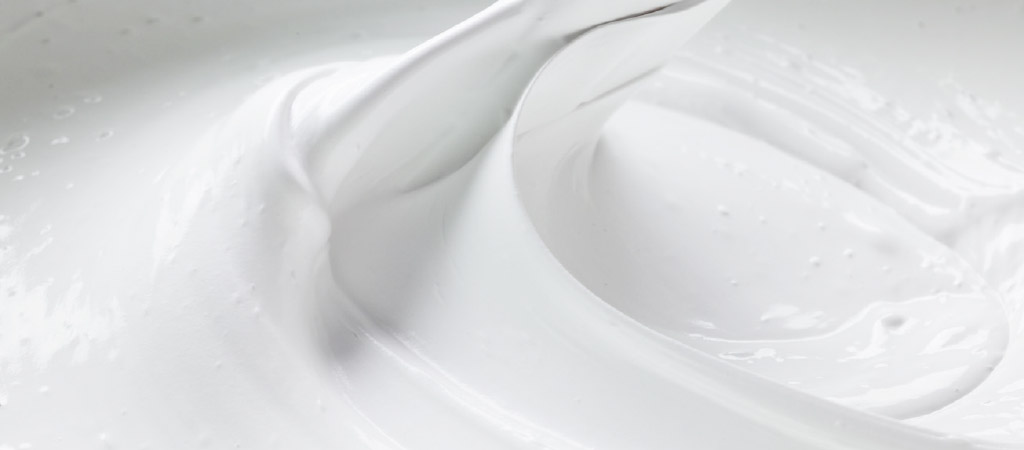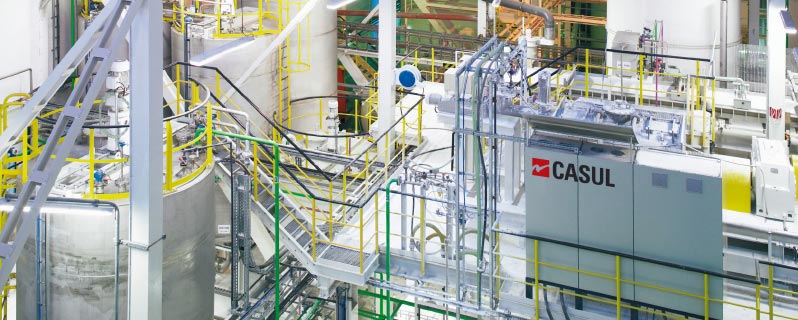The world of the
REMONDIS Lippe Plant
Whenever ‘homes’ and ‘healthy living’ cross paths, then a unique raw material is often found in the mix. Its name: CASUL. Its special features: its brilliant white colour, its great covering capacity and the fact that it contains absolutely no harmful additives. Painting is child’s play. It also mixes really well with other paint if you want to add a splash of colour.

Consumer protection
Production process
The white mineral, CASUL, is produced using a patented process owned by the company itself.
Use in the paper industry
A great glossy finish to paper products – thanks to its high opacity. Find out what it’s all about.

A patented raw material
Use in fire protection
As reliable as the fire brigade and in action 24/7 as a coating for walls.
CASUL is made using a number of ingredients including ALUMIN – a sodium aluminate that is also produced by REMONDIS
Consumers don’t just want their clothes to be white, they must be whiter than white – as can be seen by the many washing detergent ads that have been shown over the years. A product is considered to be cleaner and of a higher quality when it is a brilliant white. An additive has to be used during the production process, however, for a product to appear so white – a particularly white mineral called ettringite that can be found in nature (albeit rarely) or produced synthetically. REMONDIS succeeded in doing the latter and had the process patented as the quality was so good. Adding CASUL, the name of this synthetic raw material, to products achieves a degree of whiteness and a level of purity than could never be reached by the naturally occurring ettringite. Despite its synthetic origins, it is a naturally based product. CASUL contains absolutely no harmful ingredients.

CASUL is used in a variety of sectors, including the paint industry
Click here to reach the CASUL website and find out more about this business division
The patented raw material that is now being sold all around the world was, in fact, discovered purely by accident. In 1995, REMONDIS was looking into a new process for treating wastewater. One of the residual products of this process was an extremely white filter cake. A resourceful employee immediately came up with the idea of using this filter cake – which was actually a waste product – as a whitener. Tests were carried out to make paints with this substance and the results were so promising that the decision was made to use the “formula” of the filter cake to produce a white mineral. For reasons of quality, however, the company chose not to base its production on the original method, i.e. from residual material, but on high quality primary raw materials. The synthetic white mineral, CASUL, was here to stay.
Basically, CASUL is produced using water, lime and ALUMIN – a raw material that also comes from REMONDIS and is made at the Lippe Plant. This mixture creates CAP (a preliminary crystal structure) which then undergoes a number of stages before becoming the white mineral, CASUL.
How the white mineral is made

REMONDIS Production – a REMONDIS Group company that is responsible for developing and manufacturing innovative products – produces several thousand tonnes of CASUL every year. It has the capacity to make 15,000 tonnes.
CASUL is also used in construction chemicals, where, for example, it is mixed in with floor screed to help offset cement shrinkage
Healthy living is the focal point of all home construction and renovation projects nowadays. No matter whether it is the builder, tenant or owner – everyone prefers to use toxic-free paint and wall plaster. And it is precisely these products – i.e. environmentally friendly products – that can be made with CASUL. Paints produced using CASUL are not only odour-free, they are also completely free of additives such as fungicides or algicides. And yet they still prevent the growth of mould and bacteria both on the inside and outside of buildings. This can be put down to the high water of crystallisation content of CASUL and its high pH value. The former prevents the walls from becoming damp, the latter the growth of mould and algae – the best possible protection, therefore, for walls.

Paints produced with CASUL are biodegradable – and yet they are still a brilliant white colour and have a high covering power
CASUL is used as an additive by the paper industry to refine the surface of premium quality high gloss paper – for example, for art prints or food packaging. Once again, it is the properties of this mineral that make CASUL an ideal material for such sophisticated products. They ensure that the surface of the treated paper is both extremely smooth and a brilliant white colour – which also makes it a perfect surface for printing on. The most important criterion here is its so-called opacity: the term used to describe the quality of lacking transparency or translucence. Paper can, therefore, be refined with CASUL to create a surface that blocks out all light – not even the smallest amount of light can shine through. As a result, the colours printed on the paper appear stronger and brighter.
CASUL is a great product for combining with other minerals and extenders
CASUL is perfect for preparing the surface of paper which is to be used for printing radiant colourst
CASUL is totally harmless for both humans and the environment when used as a fire retardant. If there is a fire, it degrades into natural inert material
A white mineral as a way to prevent fires? That may sound a little weird. Obviously it is not its brilliant white colour that is useful here. It all boils down to the actual structure of the mineral. Thanks to the special production process, over 45% of CASUL is water of crystallisation. If a wall is coated with paint containing CASUL, then it is effectively being given a protective fire-resistant coating. In the case of fire, the water in the coat of paint reduces the build-up of heat on and in the wall. What’s more, the high ‘dehydration property’ of CASUL – i.e. its ability to emit water into the atmosphere even at relatively low temperatures – acts as a flame retardant.

Download the report on titanium dioxide here
A report, published by the French authorities ANES in 2016, has raised concerns as it classifies titanium dioxide as being a probable health hazard. This is certainly alarming as this white pigment is found in a whole host of products – including foodstuffs such as chewing gum. To be precise, titanium dioxide is used as an ingredient wherever a product should appear to be “whiter than white”. Many manufacturers have been looking for a safe alternative to replace the discredited titanium dioxide and have ended up at REMONDIS. CASUL, the mineral produced by REMONDIS Production, has all the properties needed – from its whiteness, to its covering capacity and opacity – and is absolutely safe. Good for the manufacturers looking to offer safe everyday products and even better for you as consumers.
Would you like to learn more about the white mineral that is made and managed by REMONDIS Production? Then simply go to casul.de

Diese Seite verwendet aktuelle Techniken, die in dem von Ihnen verwendeten Browser unter Umständen nicht korrekt
angezeigt werden können.
Bitte aktualisieren Sie Ihren Internet-Explorer oder weichen auf einen anderen Browser wie Chrome oder
Firefox aus.
Schließen